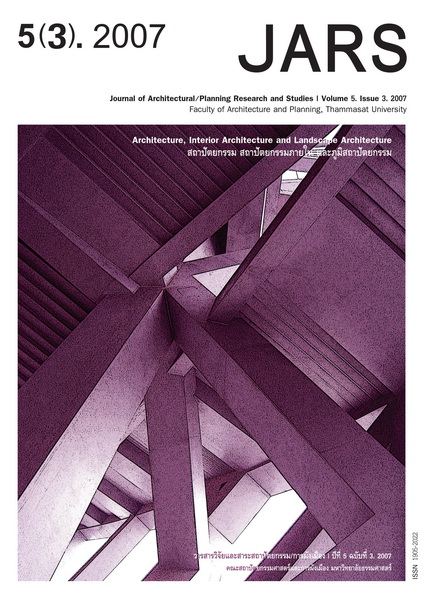Development of Tectonics in Contemporary Architecture
Main Article Content
Abstract
The term “tectonics” has carried many complicated and manifold meanings through social changes
over periods. From its origin in Greek, the word “tekton” meant builder or carpenter. During the 19th century,
tectonics was used by German theorists to define broadly to architecture’s coordination between structural
system and decorating features. For much of the 20th century, the term has advocated to the phenomenological
debate concerning in craft making and essence of dwelling. Until recent decades, tectonics has been
played more important role as a critical strategy to resist the current tendency which reduces architecture
to scenography in the age of globalization and consumerism society.
This article aims to review the many definitions of tectonics and analyzes the role and optimizing
development of tectonics in contemporary architecture. Considering the important role of tectonics, leads
to a series of merit questions on an architectural profession. The tectonic culture might reflect the position
of architects in each society. On the other hand, this quality in architecture might indicate an ethical
dimension of professional practice in the building process, and allude to the dissociation of interests
between the building profession as a whole and the users of buildings. The following questions come in
mind: What is the shape of tectonic culture in the midst of contextual changes? What is the matter for
contemporary tectonics complement or excessive quality?
Downloads
Article Details

This work is licensed under a Creative Commons Attribution-NonCommercial-NoDerivatives 4.0 International License.
All material is licensed under the terms of the Creative Commons Attribution 4.0 International (CC-BY-NC-ND 4.0) License, unless otherwise stated. As such, authors are free to share, copy, and redistribute the material in any medium or format. The authors must give appropriate credit, provide a link to the license, and indicate if changes were made. The authors may do so in any reasonable manner, but not in any way that suggests the licensor endorses you or your use. The authors may not use the material for commercial purposes. If the authors remix, transform, or build upon the material, they may not distribute the modified material, unless permission is obtained from JARS. Final, accepted versions of the paper may be posted on third party repositories, provided appropriate acknowledgement to the original source is clearly noted.
References
Frampton, K. (1996). Rappel ordre, the case for the tectonic. In K. Nesbitt (Ed.), Theorizing a new agenda for architecture: An anthology of architecture theory 1965-1995. New York: Princeton Architectural Press, 516-528.
Frampton, K. (1995). Studies in tectonic culture: The poetics of construction in nineteenth and twentieth century architecture. Massachusetts: MIT Press, 3-27.
Stereotomy มีความหมายตามพจนานุกรมว่า เทคนิคการตัดของแข็งรูปตัน (ซึ่งส่วนใหญ่เป็นจำพวกหิน) ให้ออกเป็นรูปทรงมิติต่าง ๆ ที่กำหนด โดยมาจากคำว่า stereo- (solid; ของแข็ง) บวกกับคำว่า–tomy (การตัด)
ดูอ้างอิง 2, 61-91.
วิจิตร เจริญภักตร์. (2526). สถาปัตยกรรมตะวันตก. กรุงเทพฯ: คณะสถาปัตยกรรมศาสตร์ จุฬาลงกรณ์มหาวิทยาลัย, 21.
ดูอ้างอิง 1.
Frascari, M. (1996). The tell-the-tale detail. In K. Nesbitt (Ed.), Theorizing a new agenda for architecture: An anthology of architecture theory 1965-1995. New York: Princeton Architectural Press, 498-514.
กระบวนการ “Arts and Crafts Movement” เกิดขึ้นในช่วงครึ่งหลังของศตวรรษที่ 19 โดยมีแนวความคิดที่จะต่อต้านทุก ๆ สิ่งที่เป็นผลิตผลของยุคแห่งเครื่องจักรกล (ผลลัพธ์จากการปฏิวัติอุตสาหกรรม) กระบวนการนี้มีแกนนำคนสำคัญ คือ William Morris (1834-96) ที่กล่าวไว้ว่า อุตสาหกรรมนำมาซึ่งความเลวร้ายต่าง ๆ โดยเฉพาะในสังคมเมืองและทำลาย ความสุขและความสงบสุขของมนุษยชาติ ดังนั้นเขาจึงฟื้นฟูงานหัตถกรรมของอดีตก่อนที่จะถึงยุคอุตสาหกรรม อ่าน วิจิตร เจริญภักตร์. (2526). ประวัติศาสตร์สถาปัตยกรรมตะวันตก: คริสเตียนตอนต้น-สมัยใหม่. กรุงเทพฯ: คณะสถาปัตยกรรมศาสตร์ จุฬาลงกรณ์มหาวิทยาลัย, 253.
Frascari, 506.
Ibid., 507.
Gregotti, V. (1996). The exercise of detailing. In K. Nesbitt (Ed.), Theorizing a new agenda for architecture: An anthology of architecture theory 1965-1995. New York: Princeton Architectural Press, 494-497.
ดังที่ปรากฏในงานการวิเคราะห์ข้อมูลด้านพื้นฐานการเรียนรู้ของสถาปนิกไทยในช่วงศึกษาสถาปัตยกรรม อ่านใน ผุสดี ทิพทัส. (2542). สถาปก สถาปัตยกรรม. กรุงเทพฯ: คณะสถาปัตยกรรมศาสตร์ จุฬาลงกรณ์มหาวิทยาลัย.
Ochshorn, J. (1990). Separating science from architecture: Why technology is taught outside the design studio. The Architecture of the In-Between: Proceedings of the 78th Annual Meeting of the ACSA, 1990. San Francisco, CA, 453-460.
Ochshorn, J. (1999). Dis-integrating technology and design. Retrieved March 29, 2007, from http://www.people.cornell.edu/pages/jo24/comments/Tech-design99.html
Ochshorn, J. (2004). Arch366/666 The tectonic articulation of structure: Course description. Retrieved March 29, 2007, from http://www.instruct1.cit.cornell.edu/courses/arch463/arch366f04/366f04.html
Kaewlai, P. (Ed.). (2001). 4+2 Works and activities: An annual collection of students’ works. Pathumthani, Thailand: Faculty of Architecture, Thammasat University, 10-21.
Frampton, K. (1983). Towards a critical regionalism. In H. Foster (Ed.), The anti-aesthetic: Essays on postmodern culture. Seattle, WA: Bay Press, 27.
วิวัฒน์ เตมียพันธ์. (2541). เรือนพักอาศัย: รูปแบบสำคัญของสถาปัตยกรรมพื้นถิ่น. อาษา ฉบับเดือนมกราคม 2541: สถาปนิกไทย...คืนสู่สามัญ, 61-62.
วิลเลียม ลิม. (2549). ความเป็นพื้นถิ่นร่วมสมัย. แปลและเรียบเรียงโดย ศรศักดิ์ พัฒนวศิน. ใน (โพสต์) โมเดิร์นทางเลือก: มุมมองของเอเชีย. แปลจาก Alternative (post) modernity: An Asian perspective. กรุงเทพฯ: คณะสถาปัตยกรรมศาสตร์และการผังเมือง มหาวิทยาลัยธรรมศาสตร์ และ art4d, 127-135.
ศรีศักดิ์ พัฒนวศิน และพีรดร แก้วลาย. (2546). การย้อนอ่านงานสถาปัตยกรรม: แนวทางสู่การศึกษาสถาปัตยกรรมเบื้องต้น. วารสารในการประชุมวิชาการและวิชาชีพ ครั้งที่ 1. ปี 2546. จัดโดยสภาคณบดีคณะสถาปัตยกรรมศาสตร์แห่งประเทศไทยและสมาคมสถาปนิกสยามในพระบรมราชูปถัมภ์, 182-193.
วิมลสิทธิ์ หรยางกูร และคณะ. (2536). พัฒนาการแนวความคิดและรูปแบบของงานสถาปัตยกรรม: อดีต ปัจจุบันและอนาคต. กรุงเทพฯ: สมาคมสถาปนิกสยามในพระบรมราชูปถัมภ์, 30.
Ibid., 233.
Chadanuch, W. (Ed.). (1996). Design excellence vol. III: Sumet Jumsai. Bangkok: The Key Publisher,110.
ปิยลดา เทวกุล. (2542). เรือนไทย ร่มไม้ และรากลึกแห่งความคิดและชีวิตไทย. สาระศาสตร์สถาปัตย์: วารสารวิชาการภาควิชาสถาปัตยกรรมศาสตร์ จุฬาลงกรณ์มหาวิทยาลัย, 3, 47-59.
ปิยลดา เทวกลุ. (2549). ปลุกก่อสร้าง: On the tectonic of Thai architecture. อาษา ฉบับที่ 10:49-11:49, 121-125.
พระราชบัญญัติวิชาชีพสถาปัตยกรรม พ.ศ. 2508 (ก.ส.) ว่าด้วยการให้บริการวิชาชีพของสถาปนิก หมวดพันธกรณีของสถาปนิก. อ้างในมาตรฐานการปฏิบัติวิชาชีพสถาปัตยกรรม พ.ศ. 2532 ของสมาคมสถาปนิกสยามในพระบรมราชูปถัมภ์.


